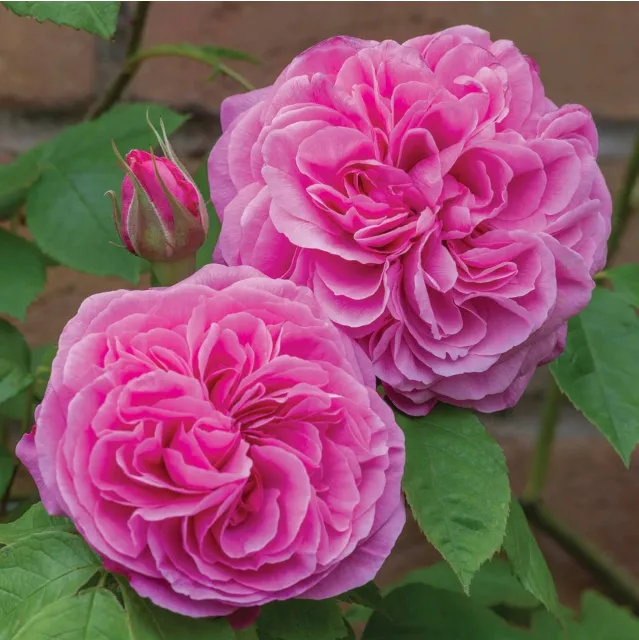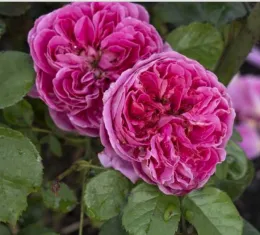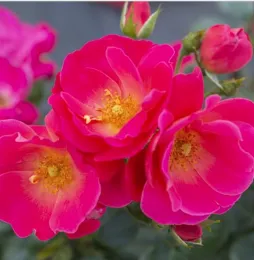Now that the weather is starting to be consistently below 90 degrees, you can fertilize your roses, if necessary. Don’t fertilize just to fertilize. Get your soil tested (if you haven’t already) to find out if you need any additional minerals to make the ingredients in your fertilizer available to the root systems of your plant. If your soil test shows your soil is adequate, no need to fertilize.
If you do need to fertilize, make sure your roses are thoroughly watered the day before applying any fertilizer, especially if you use a non-organic fertilizer, as it will burn the plant. After applying the fertilizer, water again.
You can alternate your fertilizer with fish emulsion if you wish. Use a fertilizer that has a greater percentage of (P) phosphate in relation to (N) nitrogen and (K) potassium. This will help to create stronger root systems and resistance to stress.
If you grow roses in pots (like me!) use half the recommended dose of fertilizer but apply it every two weeks. You can alternate between liquid fertilizer and dry fertilizer until 30 days before the “first frost date.” Normally, for Fresno, that is right around December 1. In our mountain areas of the county, the first frost date is (usually) about the middle of November.
You can go ahead and lightly prune your roses once the temps are consistently below 90 F. This is not the “big prune” that you will do in a couple of months. Deadhead any spent blooms down to about the third leaflet below the bloom. A leaflet is where those five or seven leaves come away from the cane. If you can, prune to an out-facing bud. Cut about a quarter inch above the bud. Make sure you wipe your pruners with an alcohol wipe to help to stop the spread of diseases. You can take off any dead leaves, but again, be careful not to expose the canes to too much sun. The sun can still burn your plants this time of year.
Keep inspecting your irrigation system to make sure it is functioning properly. Your plants in pots will need to be watered more frequently than the ones in the ground. Make sure you have mulched your roses to help them retain moisture. Three to four inches of mulch is recommended around the drip line of the plant.
Check your roses for spider mites and thrips. They love the type of weather conditions we are having. A good blast from the hose (especially under the leaves) will help control them.
American Rose Society

I attended a webinar of the American Rose Society last month on the roses the members of the society have rated the best for this year. I took particular note of several that do well in California. Just because a rose does well somewhere else (say England), doesn’t mean that it will do well in Fresno County. Many people love David Austin roses but I find some of them don’t really like our summer climate. Also, I find that many of them do very well here but tend to get much larger than in England. One such rose (very highly rated here in the U.S. and a favorite of many) is the David Austin rose Gertrude Jekyll. According to the David Austin website, the plant is supposed to get about 5 feet tall and about 3 feet wide (or so). Gertrude Jekyll is lovingly nicknamed here on the west coast as Galloping Gertie. This is a fantastic rose but gets to be much bigger here in the Central Valley than what is stated for the size back in England.
That is why I am particularly fond of rose breeders that live in the Central Valley. They know what our summers can be like. I wrote (years ago) about Ralph Moore (Visalia) as the grandfather of miniature roses. I have also written about Burling Leon (Burlington Roses in Visalia) and her fantastic roses. Another breeder from the Central Valley (Bakersfield) is Dr. Jim Sproul. Dr. Sproul is a recently retired family practice physician who also bred roses for 40 years. He was mentored by Ralph Moore and has some beautiful roses in production. Brick House Pink, Cherrytini and PowerPuff Pink are some of his highly rated roses by the members of the American Rose Society for exhibition (yes, some rosarians love to exhibit their roses at rose shows). I happen to love the rose Dainty Bess, which I have written about before. He has bred a miniature version of this rose called Baby Dainty Bess (also highly rated). Some of his roses (he has bred many!) are available through Star Roses. You can actually see some of the rose fields down in Dinuba and Sultana in the Central Valley.
You can find out more about the American Rose Society by clicking on the hyperlink. They also publish a book (a pdf version is available on the website) New Horizon Roses 2025 on the best-rated exhibition roses and on basic rose care, culture, hybridizing and breeders.
Here are some pictures of Dr. Sproul’s roses:
 |  |  |
Power Puff | Cherritini | Brick House Pink |
Until next time … As delicate as flower, as tender as rose petals, choosing to be tender and kind in a harsh environment is not weakness, it's courage.” -


